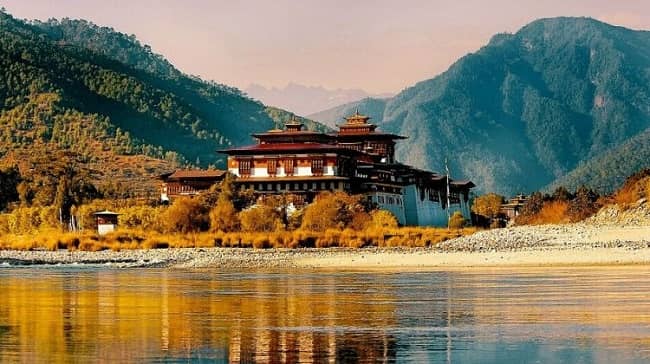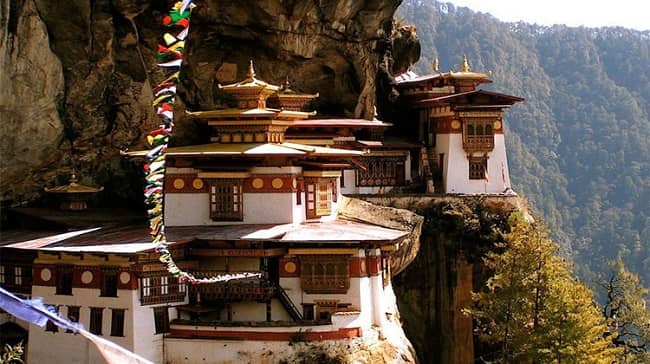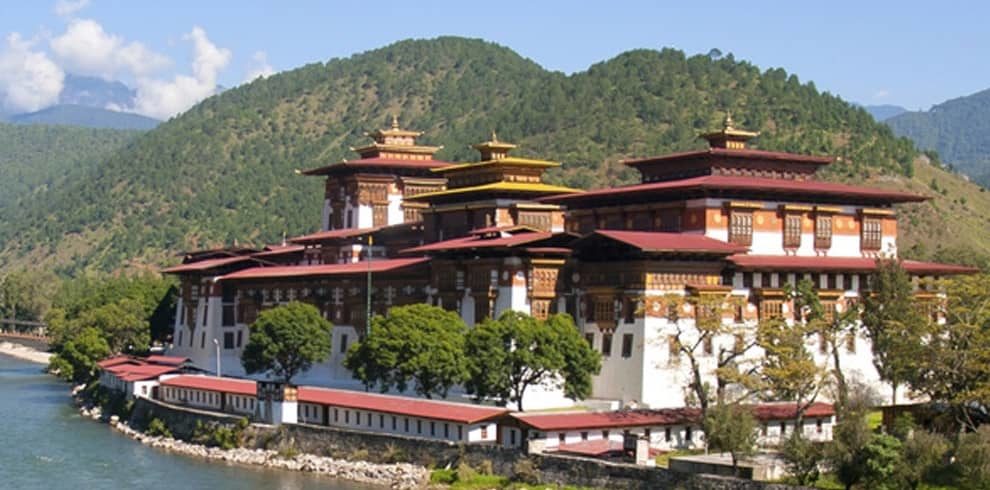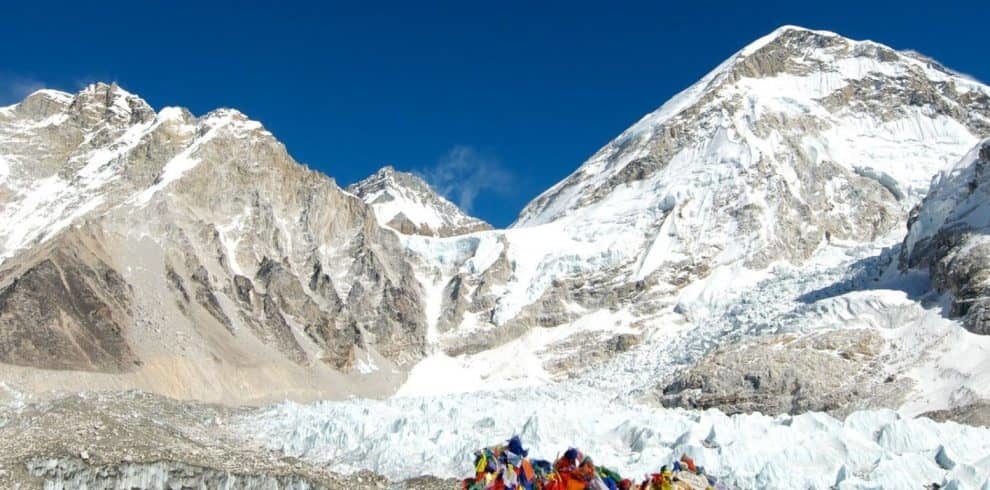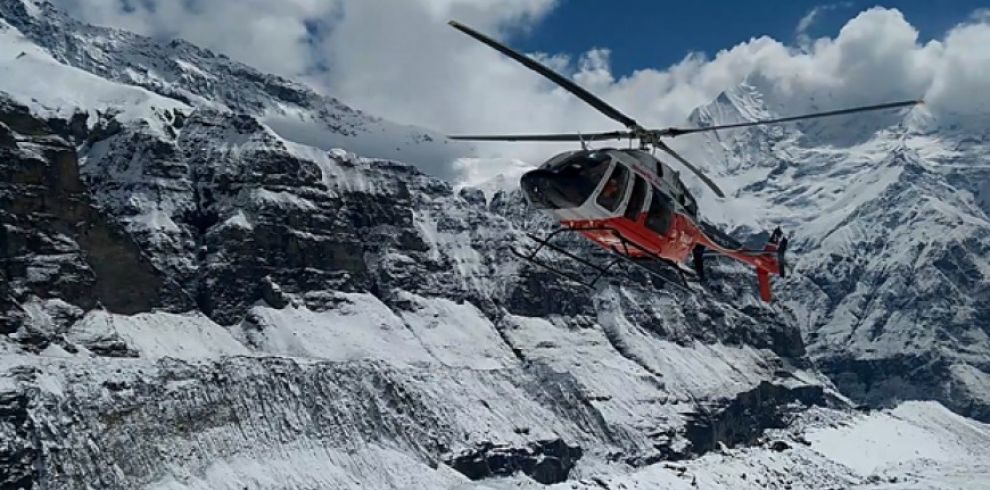Option1:HaaValleyExcursion
This morning, a magnificent drive of 1 & 12 hours will take us to Chele La pass, which is located at an elevation of around 3900m/1300ft. The Paro valley is on one side, and the Haa valley is on the other. Continue driving downwards to the banned district of Haa after a brief pause on the pass (you won't be able to stay long due to the strong wind current) (closed to tourists until 2006). If time allows, take a tour of the Haa valley and pay a visit to the chortens Nagpo and Karpo, as well as the Haa Dzong. Return to Paro after lunch at a restaurant.
If you want to stretch your legs on the way back to Paro, you can stop at a site called Dzondrakha for a climb to a monastery that appears similar to the famed Tiger's Nest monastery but is only a short distance away. If you're feeling enthusiastic, walk along the agricultural field for about half an hour; the other half will be an uphill climb, and when both excursions are combined, you'll arrive at the monastery in under an hour. When you arrive at the monastery's location, you'll be treated to a breathtaking vista of the rich Paro valley below. Your guide will take you inside the monastery's main temple.
Option 2: Hike to Takstang on Pony ride (B/L/D)
You can ride the pony up to the restaurant for a breathtaking view of the most famous Himalayan monastery, Taktshang. It is easier to return by walking downhill rather than riding a pony, which can be perilous.
Taktshang - Tiger´s Nest: Taktshang Pelphung monastery, also known as Tiger's Lair or Tiger's Nest, is one of Bhutan's most revered and well-known monasteries. It is situated on the edge of a 900m sheer cliff that rises above the Paro valley level. It's a stunning and unmissable sight, but it's only accessible by foot or by mules/ponies. If you require a riding horse, you must make arrangements with your local guide the day before. The trek from the trailhead (2600m) to the Cafeteria is a difficult one-hour ascent (about 350m ascent). One can obtain a good close-up view of Taktshang from the Cafeteria (2940m) and the surrounding surroundings. Enjoy a well-deserved cup of tea and biscuits while taking in views of the monastery from the cafeteria.
Those who intend to continue beyond this point must be able to walk. Ponies/horses will usually not take you any further than this point, nor will they take you downward. The walk continues uphill for another 45 minutes from the café to a high viewing point (3140m) with a Chorten (stupa). The view of the monastery from this vantage point is breathtaking, and it looks as if you could reach out and touch it. It's currently on the other side of a deep gorge, only about 150 meters away as the crow flies, but it'll take a half hour or more to get there. Continue down the short trail to a stunning waterfall that cascades into a deep chasm, and a retreat hermitage jammed dramatically into a rock cleft. Then proceed to the monastery by ascending a flight of hard steps. You can always turn around at any time during this trek if you find it too challenging. There are various shrines or temples to see once inside the monastery, and just a few monks live there. Most tourists plan to eat lunch at the Cafeteria after visiting the many shrines of Taktshang monastery. Retrace your steps back to the roadhead where you started in the morning after lunch. The retracing is all downhill and must be done on foot because the terrain is not suited for riding a pony or horse. Please note that this climb requires good walking footwear. There are also other monasteries, temples, and retreat homes in the Taktshang area if you have more time and are up for a more strenuous day. Zangdopelri and Ugyen Tsemo are the most notable among them, as stated separately.
Guru Padmasambhava or Guru Rinpoche, who disseminated Buddhism over the Himalayas, is claimed to have flown here on the back of a Tigress in the 8th century to conquer negative spiritual forces that were adverse to the spread of Buddhism, according to tradition. Pelgyi Senge, one of his students, mediated here in the main cave in 853. The cave is known as 'Pelphung' or 'Pelgi's cave' because his mortal bones are kept in a Stupa inside one of the temples. Many renowned spiritual gurus, including Milarepa, Thangthong Gyalpo, Phajo Dugom Zhigpo, Shadrung, and others, spent time in deep meditation here. Tenzin Rabgye erected a two-story temple around what was left of the former structure in 1692. Over the years, it has been enlarged and refurbished numerous times. Taktshang and several other temples in the vicinity were burned down in a fire in 1951, but most of them were left standing and the majority of the artifacts were rescued. It was quickly reconstructed by the entire Tsento village community. A massive fire damaged the main structure of the building and its contents once more in April of 1998. Reconstruction began in 2000 and was finished and consecrated after substantial government and donor efforts and financial support.
Beyond Takstang Description: Takstang (Tiger's Lair), also known as Taktsang Pelphung, is one of Bhutan's most revered and well-known monasteries. It's perched on the edge of a 1000-meter sheer rock above Paro Valley. It's a beautiful sight, but only accessible by pony or trek.
It takes an hour to hike uphill to the Tea House (about 350m ascent). One can obtain a close-up view of Takstang from the tea house or cafeteria (2940m), and most people return from here. We will hike uphill to a high observation point (3140m), where there is a Chorten, after tea, refreshments, and relaxation (stupa). Continue down the narrow walk down the flight of cliff-hanging steps to a stunning waterfall that cascades down the chasm, with a retreat hermitage below.
According to legend, Guru Padmasambhava, the great Buddhist master of Oddiyana (modern-day Pakistan), who disseminated Buddhism over the Himalayas, flew here in the 8th century on the back of a Tigress to conquer negative spiritual forces adverse to the propagation of Buddhism. Pelgyi Senge, one of his students, mediated here in the main cave in 853. Pelphung or Pelgyi's cave is named after the mortal remains of Pelgyi, which are housed in a stupa in the main cave. Many famous spiritual gurus spent time in deep meditation here after that. Tenzin Rabgye constructed a two-story temple here in 1692, which was later enlarged and refurbished. Tragically, two of the three temples were entirely destroyed by fire in April 1998. It has since been restored to its former glory. We will trek upward from the observation point (mentioned previously) to Zangdopelri temple after returning from the monastery tour (3250m). With an air distance of fewer than 500 meters, we can literally look down on the temple, providing a unique vista. Then, if you're up for it, we can continue trekking for another 12 hours up to Ugyen Tsemo temple, which offers spectacular views of the valley. Depending on the trail conditions, you can return to Ugyen Tshemo through a separate route that connects at the end. Go back to Paro.
Drukgyel Dzong: The remains of Drukgyal Dzong may be found 14 kilometers north of Paro town, towards the end of the paved road. The Drukgyal Dzong (victory stronghold) was constructed between 1644 and 1649 to celebrate Bhutan's triumph over Tibetan-Mongol armies. It was later destroyed in a fire in 1951. Mt. Jumolhari, Bhutan's holy peak, can be seen against the backdrop on a clear day.
